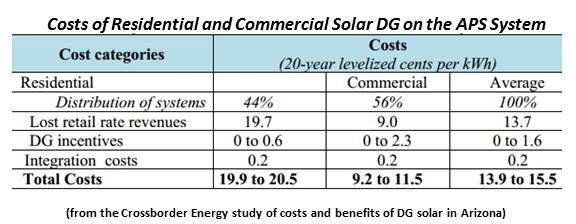Net metering of rooftop solar creates value for society and the utility. Every dollar invested by Arizona Public Service (APS), the state’s dominant utility, in its net metering program will earn it $1.54, according to a new cost-benefit analysis of Arizona solar.
By 2015, the APS net metering program will produce $34 million in net benefits yearly.
The Benefits and Costs of Solar Distributed Generation for Arizona Public Service, a report from R. Thomas Beach and Patrick G. McGuire of Crossborder Energy, is the latest in a series of studies undertaken to size up the benefits of the 43 net metering programs that are in place around the country. The first was the landmark Austin Energy (AE) Value of Solar Tariff (VOST) study by Clean Power Research.
“There are three or four dominant approaches for valuing solar, but they all seem to be coalescing around the same general conclusion,” explained Rabago Energy principal Karl Rabago, a former AE Distributed Energy Services VP and PUCT Commissioner. Rabago was instrumental in developing AE’s VOST program and is an expert on net metering and distributed generation policies.
The new studies are reaching similar conclusions, Rabago said. “It’s like climate studies. Pretty much everybody agrees now. When you account for all the value this stuff brings, it’s worth more than the cost.”
The rate impact measure (RIM) method used by Crossborder, is the “stingiest” of the cost-benefit tests, Rabago said, “the one that makes solar or energy efficiency look less cost-effective. Everybody talks about how they deny the utility the benefit of the rate payment. Here, the value of solar is net-positive against even a full rate impact analysis.”
The Crossborder researchers used data from APS and from studies APS commissioned in 2009 (the Beck study) and 2013 (the SAIC study). But they applied the data over the life of a solar system.
“A central problem with the Beck and SAIC studies is that they assess the benefits of distributed solar only in a single-year ‘snapshot,’ without considering the long-term benefits of the solar resource over its full expected life” of twenty to 30 years, they noted.
The researchers analyzed a set of benefits using the previous value of solar studies, as well as Crossborder’s own study of net metering in California. They included the following factors:
- Energy: The extent to which solar replaces the future avoided energy cost of APS’ long-term use of fossil fuels, mostly natural gas, and the fuel price hedging benefit of avoiding natural gas price volatility. The base case forecast of APS’ avoided energy costs from using distributed solar came out at “a 20-year levelized value of 7.1 cents per kilowatt-hour, in 2014 dollars.”
- Generation: Because of its contracted solar, energy efficiency, and demand response, APS needs no more new generation until 2017. Those resources will be in place and have value far beyond the avoided short-term energy costs, and may even hedge against unexpected delays in other contracted generation. The APS “levelized avoided capacity costs are $190.10 per kilowatt-year in 2014 dollars.”
- Ancillary Services and Capacity Reserves: Distributed solar reduces the APS peak load. Utilities are required to maintain operating reserves of 7 percent and capacity reserves of 15 percent. For each kilowatt cut from peak demand, the cost of maintaining reserves is reduced.
- Transmission: Distributed solar defers the cost of new and renovated transmission infrastructure. “Escalating these avoided transmission and sub-transmission costs to 2014 and using the current APS carrying charge of 11.05 percent for transmission yields a levelized avoided transmission cost of $65.14 per kilowatt-year.”
- Distribution: Distributed solar can also cut the costs of building and maintaining the distribution system. The Beck study valued the reductions at “$115,000 per megawatt of distributed generation.”
- Environmental: In a 2012 document, APS quantified the benefits of distributed solar’s reduction in air pollutants and water use.
- Avoided Renewables Costs: Distributed solar relieves APS of the need to invest in renewables to meet Arizona’s Renewable Energy Standard Tariff (REST) requirement of 15 percent in 2027, as well as in other solar to meet the REST mandate’s 30 percent distributed generation carve-out.
Crossborder also noted a spectrum of other benefits from costs deferred or avoided.

The primary cost to APS is net metering credits to system owners at APS retail rates. Currently, at $0.155 per kilowatt-hour for residential and $0.071 per kilowatt-hour for businesses, the 20-year levelized retail rate credits come to $0.197 per kilowatt-hour for residential and $0.09 per kilowatt-hour for commercial in 2014 dollars. That averages to an overall rate credit of $0.137 per kilowatt-hour.
The 20-year levelized rate of the current residential upfront incentive is $0.006 per kilowatt-hour, and most businesses no longer have access to an incentive. An APS-commissioned study put renewables integration costs at $2 per megawatt-hour in 2020 and $3 per megawatt-hour in 2030.
“Solar distributed generation with net metering is cost-effective for non-participating ratepayers in APS’ service territory,” Crossborder concluded. “The RIM test often is considered the most rigorous of the cost-effectiveness tests, [and] passing the RIM test with a benefit/cost ratio greater than 1.0 means that there are ‘no losers’ from a demand-side resource.”



